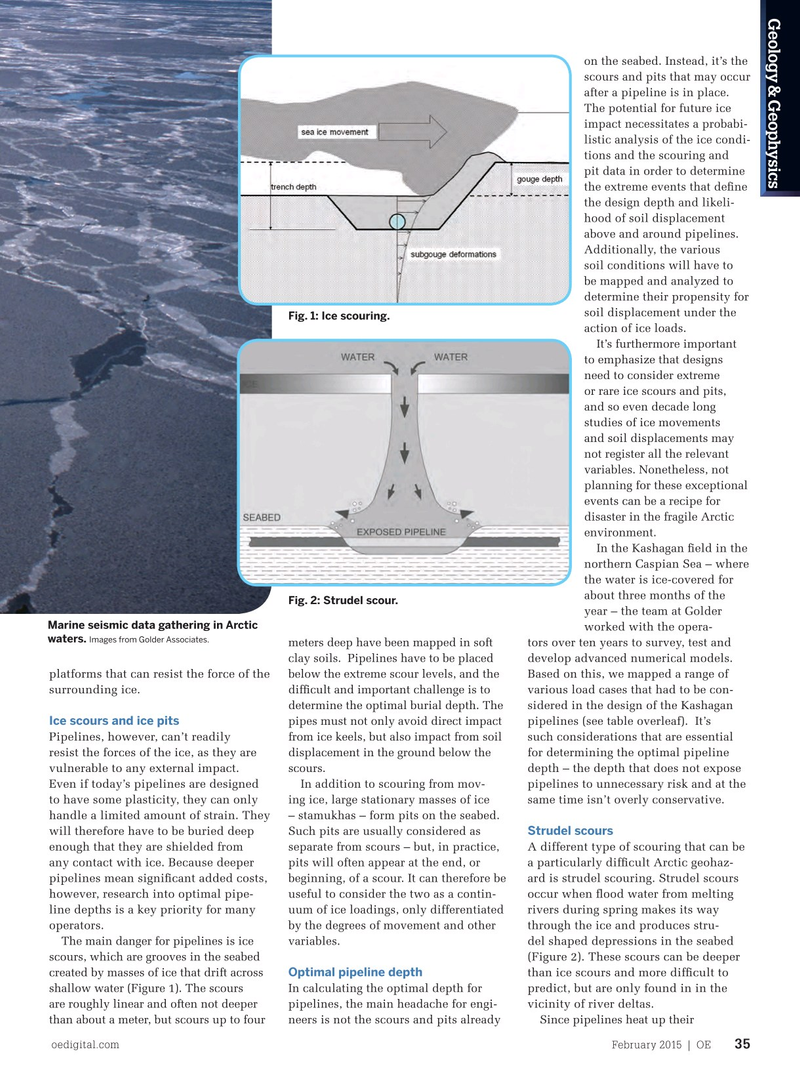
Page 33: of Offshore Engineer Magazine (Feb/Mar 2015)
Read this page in Pdf, Flash or Html5 edition of Feb/Mar 2015 Offshore Engineer Magazine
Geology & Geophysics on the seabed. Instead, it’s the scours and pits that may occur after a pipeline is in place.
The potential for future ice impact necessitates a probabi- listic analysis of the ice condi- tions and the scouring and pit data in order to determine the extreme events that defne the design depth and likeli- hood of soil displacement above and around pipelines.
Additionally, the various soil conditions will have to be mapped and analyzed to determine their propensity for soil displacement under the
Fig. 1: Ice scouring. action of ice loads.
It’s furthermore important to emphasize that designs need to consider extreme or rare ice scours and pits, and so even decade long studies of ice movements and soil displacements may not register all the relevant variables. Nonetheless, not planning for these exceptional events can be a recipe for disaster in the fragile Arctic
Keeping a cool head environment.
In the Kashagan feld in the northern Caspian Sea – where the water is ice-covered for in the Arctic about three months of the
Fig. 2: Strudel scour. year – the team at Golder
Marine seismic data gathering in Arctic worked with the opera- waters. Images from Golder Associates.
meters deep have been mapped in soft tors over ten years to survey, test and this starting point, we can more readily clay soils. Pipelines have to be placed develop advanced numerical models. platforms that can resist the force of the anticipate the various challenges facing below the extreme scour levels, and the
Based on this, we mapped a range of surrounding ice. us in the Arctic. diffcult and important challenge is to various load cases that had to be con-
The easiest way of avoiding ice is determine the optimal burial depth. The sidered in the design of the Kashagan
Ice scours and ice pits simply to drill south of the ice edge or pipes must not only avoid direct impact pipelines (see table overleaf). It’s
Pipelines, however, can’t readily such considerations that are essential out of the ice season. This, however, will from ice keels, but also impact from soil resist the forces of the ice, as they are for determining the optimal pipeline not always be possible – and, besides, the displacement in the ground below the vulnerable to any external impact. depth – the depth that does not expose
Arctic is by nature changeable, so an ice scours.
Even if today’s pipelines are designed pipelines to unnecessary risk and at the free drilling site one year will not neces- In addition to scouring from mov- to have some plasticity, they can only same time isn’t overly conservative.
sarily remain that way the next. When ing ice, large stationary masses of ice handle a limited amount of strain. They operations have to be undertaken in areas – stamukhas – form pits on the seabed.
Strudel scours will therefore have to be buried deep with ice, or risk of ice, excavated drill Such pits are usually considered as enough that they are shielded from A different type of scouring that can be centers and burying pipelines below the separate from scours – but, in practice, any contact with ice. Because deeper a particularly diffcult Arctic geohaz- deepest ice scours will be the methods to pits will often appear at the end, or pipelines mean signifcant added costs, ard is strudel scouring. Strudel scours avoid the ice. beginning, of a scour. It can therefore be
As for using ice, if it’s robust enough, however, research into optimal pipe- occur when food water from melting useful to consider the two as a contin- it can be used as a building material line depths is a key priority for many rivers during spring makes its way uum of ice loadings, only differentiated or foundation for roads, landing sites operators. through the ice and produces stru- by the degrees of movement and other
The main danger for pipelines is ice variables. or to support drilling platforms. This del shaped depressions in the seabed scours, which are grooves in the seabed can be a very benefcial addition when (Figure 2). These scours can be deeper
Optimal pipeline depth created by masses of ice that drift across building infrastructure. But when the than ice scours and more diffcult to shallow water (Figure 1). The scours In calculating the optimal depth for ice can’t be used to your advantage, predict, but are only found in in the are roughly linear and often not deeper pipelines, the main headache for engi- the remaining alternative is fghting vicinity of river deltas. than about a meter, but scours up to four neers is not the scours and pits already Since pipelines heat up their through it with ice-breaking vessels or oedigital.com February 2015 | OE 35 034_0215OE_G&G1_Golder.indd 35 1/20/15 6:16 PM

 32
32

 34
34